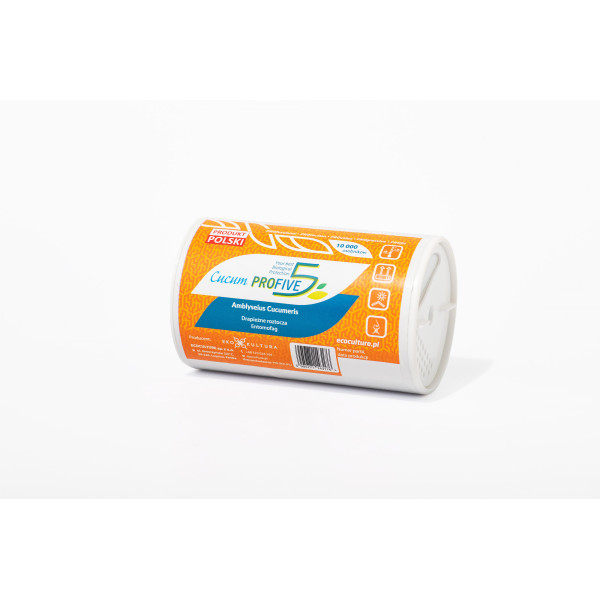What is CUCUM PRO5?
Neoseiulus cucumeris is a predatory mite from the family Phytoseiidae and is likely one of the most common and well-known entomophages used in greenhouses and conservatories. This small mite (about 0.5 mm) is white or pale yellow in color and has been actively used for many years to control thrips and some other small arthropods, such as spider mites. It reproduces rapidly and can survive in the absence of pests by feeding on plant pollen. Neoseiulus cucumeris is a good choice for combating thrips, including the dangerous quarantine pest western flower thrips. It is also effective against spider mites, which often cause damage in greenhouses and open fields. It can be used in combination with other predatory mites, such as Amblyseius swirskii and Neoseiulus californicus, to increase effectiveness in controlling thrips and other pests. The entomophage poses no threat to humans, animals, or plants, nor does it leave any residue on the product. Overall, Neoseiulus cucumeris is an effective and safe method for pest control in agriculture, horticulture, and landscaping.
Life cycle.
The life cycle of Neoseiulus cucumeris consists of several developmental stages: egg, larva, nymph, and adult. The female mite typically lays eggs on the underside of leaves. The eggs can be white or transparent and reach a diameter of about 0.2 mm. Soon, the larvae hatch and go through several larval and nymphal stages before reaching sexual maturity. The total lifespan from egg to adult averages between 10 and 14 days, depending on environmental conditions such as temperature, humidity, and food availability. Adult Neoseiulus cucumeris individuals are more active and mobile than larvae and nymphs, but all mobile stages of the mite are predatory.
Pests.
Neoseiulus cucumeris is used to control various species of thrips, such as western flower thrips (Frankliniella occidentalis), onion thrips (Thrips tabaci), and others. It can also help in controlling populations of other small pests, such as spider mites.
Crops.
It can be used on a wide range of plants, including vegetable, fruit, flower, and ornamental plants.
Vegetable and fruit crops: widely used for thrips control in cucumbers, peppers, eggplants, zucchinis, beans, strawberries, and blueberries.
Flower and ornamental plants: used on roses, gerberas, chrysanthemums, and others.
It can be applied both in open fields and on woody plants, such as citrus.
It is not recommended to use Neoseiulus cucumeris on tomatoes because it has difficulty moving on densely leafed plants.
Application.
To allow the entomophages to effectively control pests throughout the season, it is recommended to introduce them at an early stage of crop development. Before introducing the product (cardboard tube or paper bag), it should be thoroughly mixed by rotating it for several minutes around its axis to ensure an even distribution of the predators.
Neoseiulus cucumeris should be introduced carefully by sprinkling the carrier material containing the predatory mites directly onto the plant leaves. It is important to ensure that the mites are evenly distributed on the plant surface to achieve maximum effect. It is not recommended to introduce the mites on plant surfaces where pesticide residues remain.
Application rates.
The recommended application rates of Neoseiulus cucumeris may vary depending on specific crop characteristics, pest infestation levels, and other factors. Typically, they range from 500 to 1000 individuals per 1 m². The procedure should be repeated every 1-2 weeks. Before using the product, we recommend consulting our specialists in biological plant protection to determine the optimal dosage for your specific case.
Storage.
Storage should follow specific guidelines to ensure maximum effectiveness of the biological control. Here are a few recommendations:
• The maximum storage period for the product from the time of receipt is 1-2 days.
• Store the product in a horizontal position in a cool place protected from direct sunlight, at a temperature of 12-14°C. It is important to remember to avoid contact with pesticides during the storage of the mites.
• Storing the mites in a refrigerator or freezer is prohibited as it may lead to their death.
There are no reviews for this product, be the first to leave your review.

